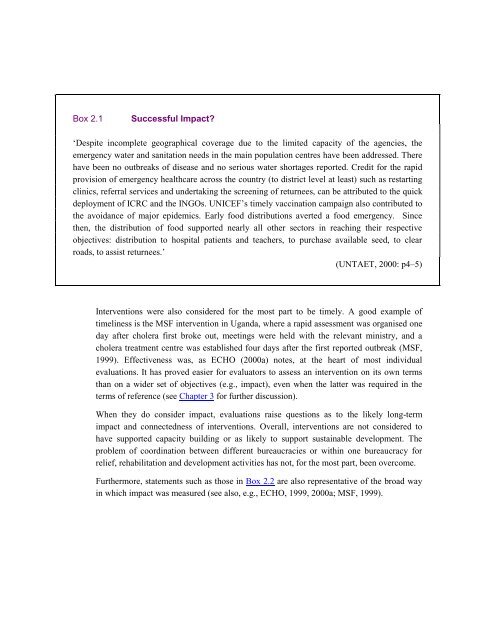Download PDF - ReliefWeb
Download PDF - ReliefWeb
Download PDF - ReliefWeb
Create successful ePaper yourself
Turn your PDF publications into a flip-book with our unique Google optimized e-Paper software.
Box 2.1 Successful Impact?<br />
‘Despite incomplete geographical coverage due to the limited capacity of the agencies, the<br />
emergency water and sanitation needs in the main population centres have been addressed. There<br />
have been no outbreaks of disease and no serious water shortages reported. Credit for the rapid<br />
provision of emergency healthcare across the country (to district level at least) such as restarting<br />
clinics, referral services and undertaking the screening of returnees, can be attributed to the quick<br />
deployment of ICRC and the INGOs. UNICEF’s timely vaccination campaign also contributed to<br />
the avoidance of major epidemics. Early food distributions averted a food emergency. Since<br />
then, the distribution of food supported nearly all other sectors in reaching their respective<br />
objectives: distribution to hospital patients and teachers, to purchase available seed, to clear<br />
roads, to assist returnees.’<br />
(UNTAET, 2000: p4–5)<br />
Interventions were also considered for the most part to be timely. A good example of<br />
timeliness is the MSF intervention in Uganda, where a rapid assessment was organised one<br />
day after cholera first broke out, meetings were held with the relevant ministry, and a<br />
cholera treatment centre was established four days after the first reported outbreak (MSF,<br />
1999). Effectiveness was, as ECHO (2000a) notes, at the heart of most individual<br />
evaluations. It has proved easier for evaluators to assess an intervention on its own terms<br />
than on a wider set of objectives (e.g., impact), even when the latter was required in the<br />
terms of reference (see Chapter 3 for further discussion).<br />
When they do consider impact, evaluations raise questions as to the likely long-term<br />
impact and connectedness of interventions. Overall, interventions are not considered to<br />
have supported capacity building or as likely to support sustainable development. The<br />
problem of coordination between different bureaucracies or within one bureaucracy for<br />
relief, rehabilitation and development activities has not, for the most part, been overcome.<br />
Furthermore, statements such as those in Box 2.2 are also representative of the broad way<br />
in which impact was measured (see also, e.g., ECHO, 1999, 2000a; MSF, 1999).
















![CynefinFramework final [Read-Only]](https://img.yumpu.com/19017304/1/190x135/cynefinframework-final-read-only.jpg?quality=85)